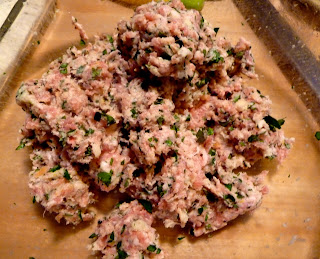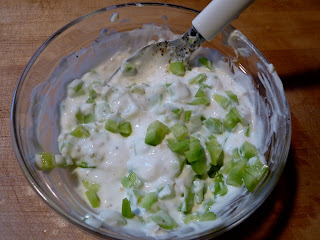I thought I'd continue my attempt to seduce you with recipes from the extraordinary All About Braising by Molly Stevens. So, I prepared her Tuna Steaks Braised with Radicchio, Chickpeas and Rosemary for dinner last week.
Braised fish just isn't a big part of my repertoire.
As I mentioned previously, it is important to mix things up. Writing a blog is very helpful in identifying the rut that you may be stuck in at any particular moment.
I mean, just how many times can I mention roasting salmon, before I bore you to tears?!
And enough is enough with the pork already!
I am very tired of seared tuna.
As I mentioned previously, it is important to mix things up. Writing a blog is very helpful in identifying the rut that you may be stuck in at any particular moment.
I mean, just how many times can I mention roasting salmon, before I bore you to tears?!
And enough is enough with the pork already!
Braising tuna is a pleasant change. Marrying the braised tuna with braised radicchio and chickpeas that have first been sautéed with rosemary and garlic infused olive oil produces an unusual yet elegant dinner.
The herbaceous oil and the radicchio and chickpeas are so well suited to each other that I would very happily make only this part of the dish and serve it alone for lunch or as a side to other proteins like grilled rib-eye or roasted chicken.
I used Albacore tuna, but I'm curious if using Ahi tuna would have made an appreciable difference. I may try that the next time I'm feeling a bit more flush.
Braised in this fashion, the tuna is meaty and substantial. While this dish is certainly light enough to be enjoyed as summer-fare, it would be equally appropriate in the winter thanks to its warming soupiness, soft legumes and the use of piney rosemary.
The herbaceous oil and the radicchio and chickpeas are so well suited to each other that I would very happily make only this part of the dish and serve it alone for lunch or as a side to other proteins like grilled rib-eye or roasted chicken.
I think braised chicories are divine, whether it be radicchio, endive, or escarole. Their pleasing bitterness turns slightly sweet and luscious.
We should all be eating more of them!
Braised in this fashion, the tuna is meaty and substantial. While this dish is certainly light enough to be enjoyed as summer-fare, it would be equally appropriate in the winter thanks to its warming soupiness, soft legumes and the use of piney rosemary.
This dish is delicious right off of the stove, but it also tastes terrific the next day served at room temperature. Don't try to reheat it, because it will become a dried out mess!
Tuna Steaks Braised with Radicchio, Chickpeas & Rosemary
1/3 cup extra-virgin olive oil, plus more for drizzling
4 garlic cloves, cut into slivers
2 teaspoons coarsely chopped fresh rosemary
1/4 teaspoon crushed red pepper flakes
1 medium head radicchio (about 6 ounces)
1 cup chicken stock
1 tablespoon freshly squeezed lemon juice, plus more to taste
One 15 1/2-ounce can chickpeas, drained and rinsed (1 1/2 cups)
Kosher salt
1 3/4 pounds tuna steaks (usually 2 good-sized steaks), about 1 1/4 inches thick
Freshly ground black pepper
2 tablespoons coarsely chopped flat-leaf parsley
Fleur de sel or coarse sea salt (I used Maldon)
Combine the oil, garlic, rosemary, and pepper flakes in a medium high-sided skillet (10- or 12-inches). Heat over low heat, covered, until the garlic is fragrant, soft, and lightly golden, 4 to 5 minutes. Lift the lid frequently to check that the garlic isn't frying or browning. Set aside.
Cut the radicchio in half from core to top. Carve out the small core. Place the halves cut side down on a cutting board and slice into 1/2-inch-wide shreds. Add these to the infused olive oil Return the skillet to medium heat and sauté, stirring occasionally, until the radicchio is wilted, about 5 minutes.
Add the stock, lemon juice, chickpeas, and a pinch of salt to the pan. Bring to a simmer, cover, and simmer gently for 8 to 10 minutes.
Season the tuna steaks on both sides with salt and pepper. Set them on top of the chickpeas and radicchio, and reduce the heat to low. Cover and braise gently, lifting the lid once or twice to check that the liquid is simmering quietly, not violently. If necessary, lower the heat, or set a heat diffuser beneath the pan. After 8 to 10 minutes, the tuna steaks should be cooked halfway through. Carefully turn the steaks. Cover them with some chickpeas and radicchio. Replace the cover and braise gently until the steaks are just cooked through, another 6 to 8 minutes. Prod the center of a steak with a paring knife and peek to see that it's cooked to your liking.
Transfer the tuna steaks to a cutting board and divide into serving pieces. Set the tuna in warm shallow pasta bowls. Stir the parsley into the pan, taste for salt and pepper, and spoon the chickpea-radicchio garnish, along with plenty of liquid over the tuna. Finish each serving with a squeeze of lemon juice, a thread of good olive oil, and a pinch of fleur de sel or coarse sea salt.
Serves 4
1/3 cup extra-virgin olive oil, plus more for drizzling
4 garlic cloves, cut into slivers
2 teaspoons coarsely chopped fresh rosemary
1/4 teaspoon crushed red pepper flakes
1 medium head radicchio (about 6 ounces)
1 cup chicken stock
1 tablespoon freshly squeezed lemon juice, plus more to taste
One 15 1/2-ounce can chickpeas, drained and rinsed (1 1/2 cups)
Kosher salt
1 3/4 pounds tuna steaks (usually 2 good-sized steaks), about 1 1/4 inches thick
Freshly ground black pepper
2 tablespoons coarsely chopped flat-leaf parsley
Fleur de sel or coarse sea salt (I used Maldon)
Combine the oil, garlic, rosemary, and pepper flakes in a medium high-sided skillet (10- or 12-inches). Heat over low heat, covered, until the garlic is fragrant, soft, and lightly golden, 4 to 5 minutes. Lift the lid frequently to check that the garlic isn't frying or browning. Set aside.
Cut the radicchio in half from core to top. Carve out the small core. Place the halves cut side down on a cutting board and slice into 1/2-inch-wide shreds. Add these to the infused olive oil Return the skillet to medium heat and sauté, stirring occasionally, until the radicchio is wilted, about 5 minutes.
Add the stock, lemon juice, chickpeas, and a pinch of salt to the pan. Bring to a simmer, cover, and simmer gently for 8 to 10 minutes.
Season the tuna steaks on both sides with salt and pepper. Set them on top of the chickpeas and radicchio, and reduce the heat to low. Cover and braise gently, lifting the lid once or twice to check that the liquid is simmering quietly, not violently. If necessary, lower the heat, or set a heat diffuser beneath the pan. After 8 to 10 minutes, the tuna steaks should be cooked halfway through. Carefully turn the steaks. Cover them with some chickpeas and radicchio. Replace the cover and braise gently until the steaks are just cooked through, another 6 to 8 minutes. Prod the center of a steak with a paring knife and peek to see that it's cooked to your liking.
Transfer the tuna steaks to a cutting board and divide into serving pieces. Set the tuna in warm shallow pasta bowls. Stir the parsley into the pan, taste for salt and pepper, and spoon the chickpea-radicchio garnish, along with plenty of liquid over the tuna. Finish each serving with a squeeze of lemon juice, a thread of good olive oil, and a pinch of fleur de sel or coarse sea salt.
Serves 4


























































